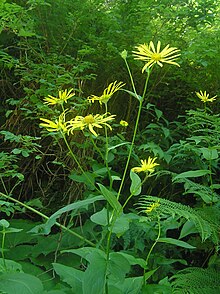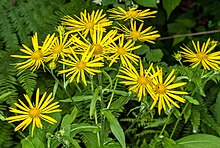Austrian chamois
| Austrian chamois | ||||||||||||
|---|---|---|---|---|---|---|---|---|---|---|---|---|

Austrian chamois ( Doronicum austriacum ) |
||||||||||||
| Systematics | ||||||||||||
|
||||||||||||
| Scientific name | ||||||||||||
| Doronicum austriacum | ||||||||||||
| Jacq. |
The Austrian chamois ( Doronicum austriacum ) is a species of the genus chamois ( Doronicum ) in the sunflower family (Asteraceae). It thrives in the mountains of Europe and Asia Minor.
description
The Austrian chamois is very variable in some characteristics, especially in the number of flower heads, the shape of the bracts and the hairiness. It has similar characteristics to Doronicum carpetanum and the creeping chamois ( Doronicum pardalianches ) and can therefore be confused with them.
Appearance and foliage leaf
The Austrian chamois grows as a perennial , herbaceous plant and reaches heights of about 30 to 150 centimeters. It has a more or less woody rhizome as a storage organ, which is bare and has neither scales nor remains of leaves. Runners are not formed. Its upright, angular stem , branched in the upper area, is glabrous in the lower area and more or less softly hairy and glandular in the upper area . The internodes are always shorter than the nearby leaves.
The leaves are basal and alternately distributed on the stem. The basal leaves, which are already dry at the time of flowering, are stalked and have a simple, deeply heart-shaped leaf blade with an oval shape and a serrated leaf margin. The seated stem leaves differ in some characteristics depending on their position on the stem. The lower stem leaves are smaller, encompassing the stem and shaped like a violin in outline; the middle ones are larger, more or less heart-shaped, encompassing stems with detached ears; the abruptly narrowed bottom is striking. The leaf margin is serrated. The upper stem leaves are ovate-lanceolate and more or less glandularly hairy, with entire margins or finely serrated.
Inflorescence and flower
The flowering period extends from June to August. In a loose, umbelliferous total inflorescence, there are usually five to twelve (rarely up to 17) cup-shaped partial inflorescences. The glandular hairy inflorescence shafts have a length of 1.5 to 16 cm and a diameter of 0.5 to 2 mm. The inflorescence envelope is shorter than the ray florets and has a diameter of 1.5 to 3.5 cm. The herbaceous, sometimes paper-like bracts at the base and edge are egg-shaped-sub-like and always with a pointed upper end, while the outer have a length of 0.5 to 1.8 cm and a width of 1.2 to 4 mm and the inside a length of 0.6 to 1.4 cm and a width of 0.7 to 3 mm. The bracts are seldom glabrous, usually hairy glandular or non-glandular. The inflorescence base is downy hairy, rarely glabrous. The flower heads have a diameter of mostly 5 to 6 (3.5 to 8) cm up to the tips of the ray flowers.
The flower heads contain golden yellow tongue (= ray) and tubular flowers (= disc flowers). The petals are covered with glandular and glandular ciliate villi on the edge. The ray florets have a length of (1.2 to) usually 1.5 to 3.5 cm and a width of (1 to) usually 2 to 4 mm oblong-elliptical to obovate-elliptical with a tricuspid Tongue. In tubular flowers, the crowns are 4.5 to 5.5 mm long and 1 to 1.5 mm in diameter.
fruit
The achenes have a brown to olive green tinted, grooved, net-like surface and are different in the ray and disc flowers ( heterocarpy ). The bald achenes of the ray-flowers, 2 to 3.5 mm long and 0.7 to 1.3 mm wide, have no crown of hair ( pappus ). The downy hairy, 1.5 to 3 mm long and 0.7 to 1 mm wide achenes of the disc flowers have a white, 3 to 6 mm long hair crown (pappus).
Chromosome number
The number of chromosomes is 2n = 60. Doronicum austriacum is diploid.
Systematics
The first publication of Doronicum austriacum was made in 1774 by Nicolaus Joseph von Jacquin in his work Florae Austriacae sive plantarum selectarum in Austriae archiducatu sponte crescentium icones in Volume 2, page 18, they found there also displayed in Volume 2 on blackboard 130th
One can distinguish the following subspecies:
- Doronicum austriacum subsp. austriacum
- Doronicum austriacum subsp. giganteum (Griseb.) Stoj. & Stef. : It occurs in Greece, Albania, Bulgaria, Serbia, Macedonia and Turkey.
Occurrence
distribution
The distribution area of the Austrian chamois ranges from the mountains of Central and Southern Europe from France to the Carpathians , south to northwestern Spain, the northern Apennines and northern Greece, and also to Asia Minor . The Austrian chamois is absent in the western Alps and Switzerland . In the Alps, their western border runs at Königssee , Kitzbühel and Monte Baldo . In Germany, the Austrian chamois is only found in the southern part of the Bavarian Forest and in the Berchtesgaden Alps . The distribution area includes the countries Spain, Andorra, France, Germany, Austria, Italy, Croatia, Slovenia, the Balkan Peninsula, Bulgaria, the Czech Republic, Poland, Slovakia, Romania, Hungary and Turkey. The Austrian chamois is sometimes used as an ornamental plant in gardens. It has feral in the UK .
Location
The Austrian chamois usually grows in groups in fresh, often shady locations, preferably at springs or streams, in tall forbidden fields, in meadows and in forests, mainly in the montane to subalpine altitude range at altitudes between usually 600 to 2000 (300 to 2200) meters, very rarely also deeper.
Plant sociology
The Austrian chamois has its main occurrence in the Association of Alpine Lägerfluren ( Rumicion alpini Klika et Had. 1944) within the order of mugwort and burdock flurs ( Artemisietalia Lohm. Apud. TX). It is a characteristic of the association of tall herbaceous vegetation ( Adenostylion alliariae Br.-Bl. 1925), which belongs to the class of high-montane subalpine tall herbaceous vegetation and bushes ( Betulo-Adenostyletea Br.- within the order of tall herbaceous areas ( Adenostyletalia Br.-Bl. 1931) Bl. Et Tx. 1943).
Common names
The other German-speaking common names Ganswurz ( Carinthia ) and wilder tobacco (Carinthia in Katschtal ) exist or existed for Austrian chamois .
swell
literature
- Ines Álvarez Fernández: Systematics of Eurasian and North African Doronicum (Asteraceae: Senecioneae) . In: Ann. Mon. Bot. Gard. , 2003, Volume 90, Number 3, pp. 319-389. doi : 10.2307 / 3298534 scanned at biodiversitylibrary.org . Doronicum austriacum at pp. 341-342.
- Ian Keith Ferguson: Doronicum L . In: Flora Europaea Volume 4, pp. 190-191, Cambridge 1976.
- Gerhard Wagenitz: Compositae II: Matricaria-Hieracium . In Gustav Hegi: Illustrated Flora of Central Europe . Volume VI, part 4. 2nd edition, Paul Paey Verlag, Berlin, Hamburg 1987.
- Erich Oberdorfer: Plant-sociological excursion flora for Germany and neighboring areas . 8th edition, Verlag Eugen Ulmer, Stuttgart 2001.
- Austrian chamois. In: FloraWeb.de.
Single receipts
- ↑ a b c d e f g h i j Ines Álvarez Fernández: Systematics of Eurasian and North African Doronicum (Asteraceae: Senecioneae) , In: Ann. Mon. Bot. Gard. , 2003, Volume 90, Number 3, pp. 319-389. doi : 10.2307 / 3298534 scanned at biodiversitylibrary.org . Doronicum austriacum at pp. 341-342.
- ↑ Wolfgang Adler, Karl Oswald, Raimund Fischer: Excursion flora from Austria . Ed .: Manfred A. Fischer. Eugen Ulmer, Stuttgart / Vienna 1994, ISBN 3-8001-3461-6 .
- ↑ a b Austrian chamois. In: FloraWeb.de.
- ↑ Werner Rothmaler (greeting), Eckehart J. Jäger, Klaus Werner (ed.): Exkursionsflora von Deutschland. Volume 2. Vascular plants: base volume. 18., arr. Ed., Spektrum, Heidelberg et al. 2002, ISBN 3-8274-1359-1 : p. 448
- ↑ a b c Werner Greuter (2006+): Compositae (pro parte majore). - In: W. Greuter & E. von Raab-Straube (ed.): Compositae. Euro + Med Plantbase - the information resource for Euro-Mediterranean plant diversity. Datasheet Doronicum austriacum In: Euro + Med Plantbase - the information resource for Euro-Mediterranean plant diversity.
- ^ Georg August Pritzel , Carl Jessen : The German folk names of plants. New contribution to the German linguistic treasure. Philipp Cohen, Hannover 1882, page 137. ( online ).
Web links
- Doronicum austriacum Jacq., Austrian chamois root. In: FloraWeb.de.
- Austrian chamois . In: BiolFlor, the database of biological-ecological characteristics of the flora of Germany.
- Profile and distribution map for Bavaria . In: Botanical Information Hub of Bavaria .
- Thomas Meyer: Gemswurz data sheet with identification key and photos at Flora-de: Flora von Deutschland (old name of the website: Flowers in Swabia )




